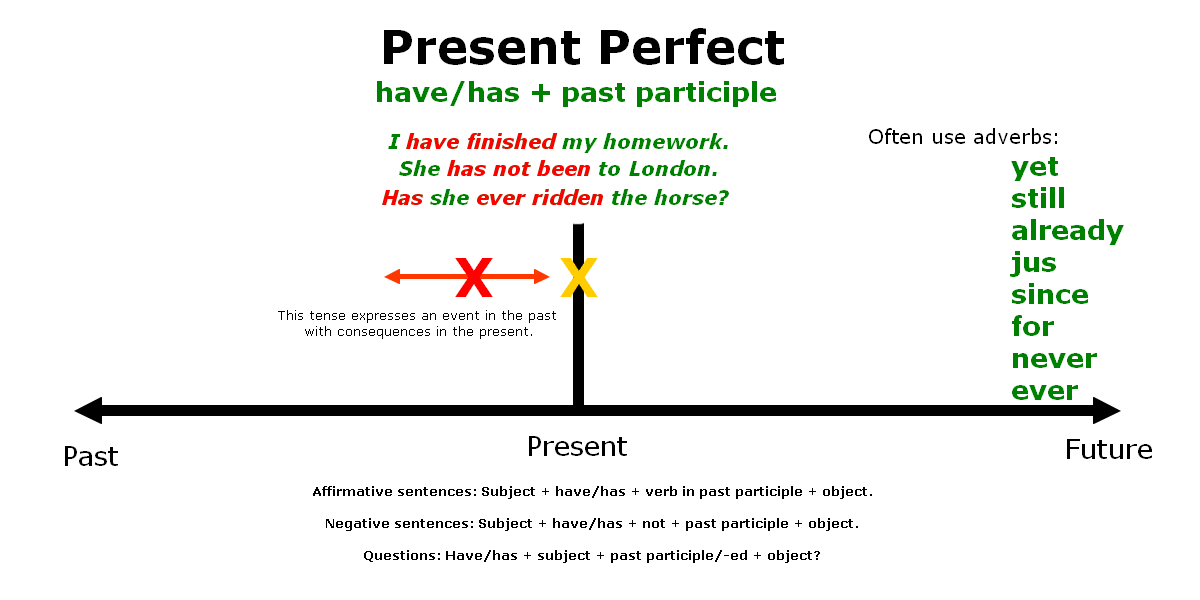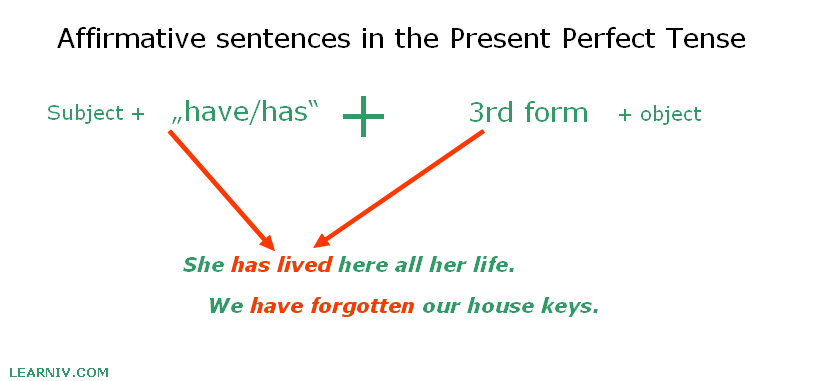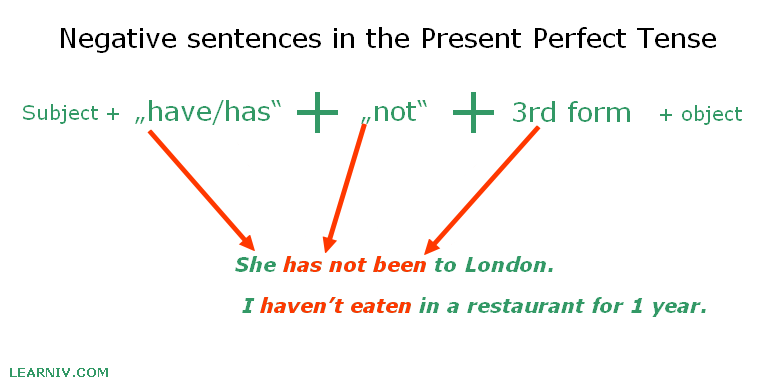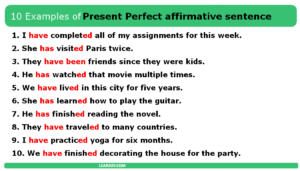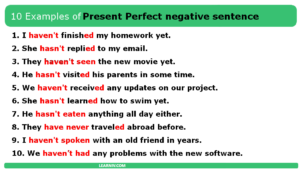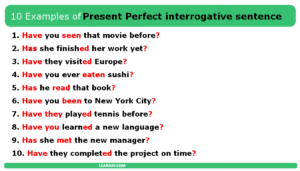The present perfect tense is a combination of the present tense and perfect aspect that expresses an event in the past with consequences in the present.
For this tense we use auxiliary verbs in their base form in combination with main verbs in their past participle form. This tense is quite easy to learn but harder to use in practice, but nonetheless it’s a tense we must know. To properly construct sentences, we have to learn all the irregular verbs and know their forms.
Look at present perfect tense examples.
The formula for the present perfect tense
To form the present perfect tense we need to use the auxiliary verb „have“. This verb is combined with a verb in the past participle form (in the 3rd form).
The present perfect is little bit harder in the sense that we have to distinguish between the person and the number of subjects. We need to know when to use the verb „have“ or when „has“ should be used instead. We must also learn all the irregular verbs.
The structure of the sentence is:
Subject + have + verb in the past participle + object.
If the verb is not irregular, we just add the suffix –ed to the end of it. For example, the verb „like“ would turn into „liked“.
Affirmative sentences in the present perfect tense
Affirmative sentences in the present perfect are easy to construct. These sentences are made from the auxiliary verb „have“ and the 3rd form of the irregular main verb (past participle). To use the verb „have/has“ correctly, we must distinguish between whether the person is plural or singular, as well as the number of subjects.
These verbs are really important to the entire sentence as they allow us to know that the speaker is talking in the present continuous. As a result, we know something happened in the past that led to some effects in the present.
When do we use the verb „have/has“?
We use the form „have“ or „has“ of the verb when we are talking in the present perfect tense. We always have to use it as an auxiliary verb, otherwise we would not be talking in the present perfect tense. When do we use the form „have“ and „has? “
Form „has“
The form „has“ is used with the 3rd person singular (He, she, it).
Examples:
- He has visited her twice.
- She has watered the garden.
Form „have“
We use this form in combination with all other persons, except for the 3rd person singular.
Examples:
- We have done this before.
- They have seen him this week.
This tense is a little bit harder because we need to know all the irregular verbs and their form. If we do not know them, we will be unable to construct sentences. Once we learn all the irregular verbs, constructing sentences is easy.
If the verb is not irregular, we need to slightly modify the verb by adding the suffix – ed to the end of the main verb.
The structure of the sentence is:
Subject + have/has + verb in past participle + object.
Examples:
- She has lived here all her life.
- I have finished my homework.
- We have forgotten our house keys.
Negative sentences in the present perfect tense
If we want to construct a negative sentence, we have to add the word „not“ right after the auxiliary verb „have/has“. This means we will use the form „have/has not“, or we can also use the shorter forms „haven’t“ or „hasn’t“.
The short-forms are better to use in informal settings such as when you are talking with your friends or family. If we want to talk politely or formally with someone, it’s preferable to use the whole formula.
The structure of negative sentences in the present perfect tense is:
Subject + have/has + not + past participle + object.
Examples:
- She has not been to London.
- I haven’t eaten in a restaurant for 1 year.
- She still hasn’t forgiven me.
Questions in the present perfect tense
If we want to construct questions in the present perfect tense, we just need to switch up the word order a little bit. Just like in the construction of affirmative and negative sentences, we need to pay attention to the person and number of subjects to select the correct form of the verb „have“.
The structure of questions in the present perfect is:
Have/has + subject + past participle/-ed + object?
Examples:
- Have you ever tried to change your hairstyle?
- Has she ever ridden the horse?
- Have they ever shot a gun?
More examples of Present Perfect sentences
- Other examples:
When do we use the present perfect tense?
We use the present perfect tense in many situations, specifically those which started in the past and have not yet ended but which are impacting the present. Of course, there are some exceptions – we can use the present perfect on certain occasions when events have finished in the past.
1. Recent actions
We use the present perfect to talk about recent actions or to ask about events that have recently happened. Adverbs such as yet, still, already or just are very often used in these cases. We use the tense if a situation led to some effect in the present.
Examples:
- I have lost my wallet so I cannot buy anything.
- Have you done your homework yet?
2. Life experiences
This tense is used to talk about life experiences. We can describe some facts or things that happened in our lives without referring to any specific time period.
Examples:
- She has visited Italy 6 times!
3. Unfinished actions
The main purpose of this tense is to talk about unfinished actions that started in the past and continue to the present. We often use the adverb „since“ when we start talking about something in the past and the adverb „for“ when talking about an unfinished time period.
Examples:
- We have lived in Prague for 5 years.
- They have lived together since 2009.
4. Adverbs „ever“ and „never“
We also use the present perfect in combination with the adverbs „never“ and „ever“, which are commonly applied when talking about positive or negative situations in our lives.
Examples:
- I have never been to Moscow.
5. Finished actions in someone’s life (the person is still alive)
This tense is also used to describe a finished period in someone’s life. If the person is no longer alive, we cannot use the present perfect but instead would use the past simple. But because the person is still alive, we can use the present perfect to talk about a finished event in his life.
Examples:
- My wife has been in Budapest for 6 months.
6. Finished action with results in the present
We can also talk about a finished action in the past which has results in the present. This is usually some kind of event that recently happened.
Examples:
- He has stolen my keys.
The above example means someone stole my keys and now I cannot get home (sequences in the present). If we were to use the past simple „He stole my keys,“ this would mean that I already have my new keys and my stolen keys are no longer a problem (I can get home – no sequences in the present).
The past simple versus the present perfect tense
The main difference between the present perfect tense and the past simple tense is in the duration of the event. While in the past simple we talk about an action that has been completed in the past, in the present continuous we are talking about events that started in the past but are still lasting in the present (they didn’t end in the past).
Present perfect:
Today, this week, since, in the last months, for, just, recently, up to now, already, until now, ever, etc.
Past simple:
Yesterday, last week, last month, a few months ago, in 2011, when, while, etc.
Examples:
- Present perfect: I have known Mary for 6 years.
- Past simple: I knew Mary for 6 years.
Even though the two sentences above may look similar, there is a big difference between them. The first sentence (present perfect) states that I have known Mary for 6 years and we are still in contact – I still know her.
The second sentence (past simple) states that I knew her for 6 years but then we lost contact – I don’t know her now as we lost touch.
Remember, we cannot use the present perfect in situations that have finished. We always use it for unfinished events. If we are talking about events that finished in the past, we use the past simple.
Look also at the article of the past perfect tense.
Regular verbs
There are some spelling rules that exist when adding the suffix –ed to certain regular verbs.
If the infinitive verb ends with the letter „e“, then we just add the suffix –„d“.
- Agree –> Agreed
- Lie –> Lied
If the verb in infinitive form ends with a vowel and a consonant, the consonant is doubled and we add the suffix –ed.
- Stop –> Stopped
- Plan –> Planned
If the infinitive verb ends with the letter „y“, we change the „y“ to „-ied“.
- Try –> Tried
- Carry–> Carried
If the verb in infinitive form ends with a vowel and the letter „y“, then we just add the suffix „–ed“.
Pronunciation
The pronunciation of irregular verbs is really important to know. Many irregular verbs have the same written form but different pronunciations. That‘s the main reason why we need to memorize them really well.
Regular verbs have one simple pronunciation rule:
- Verbs ending with voiced consonants are pronounced as /d/
- Verbs ending with unvoiced consonants are pronounced as /t/
